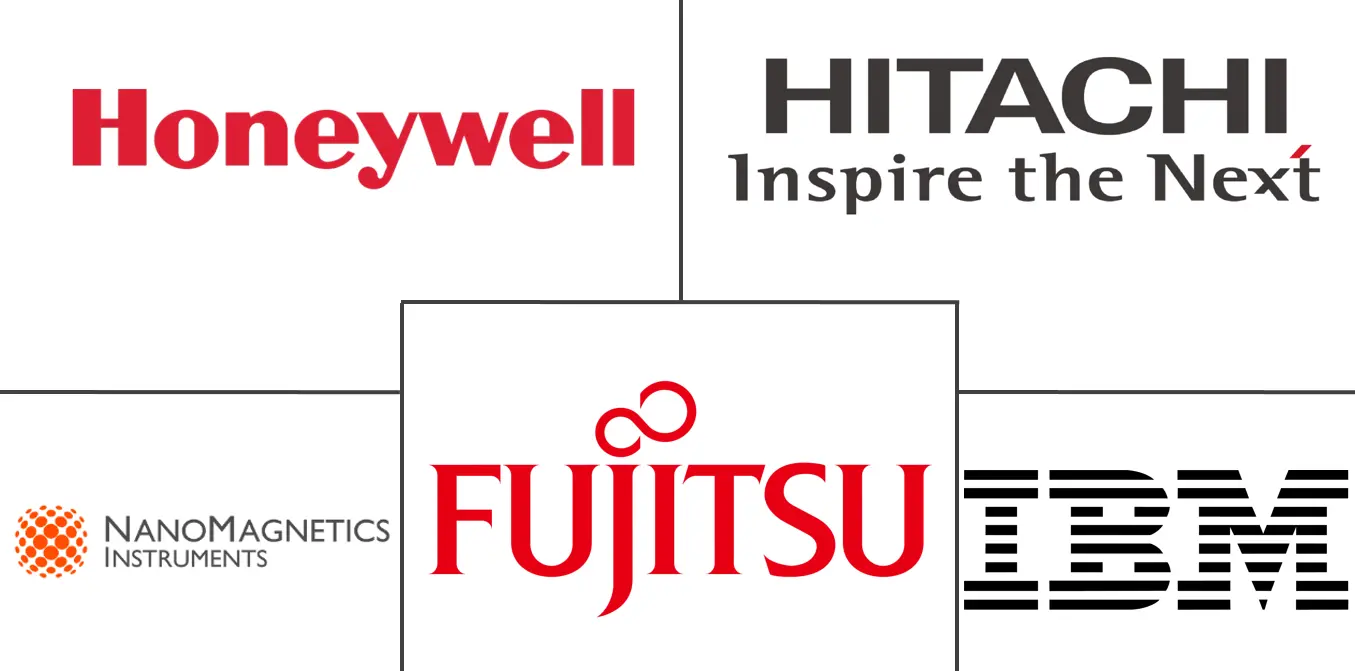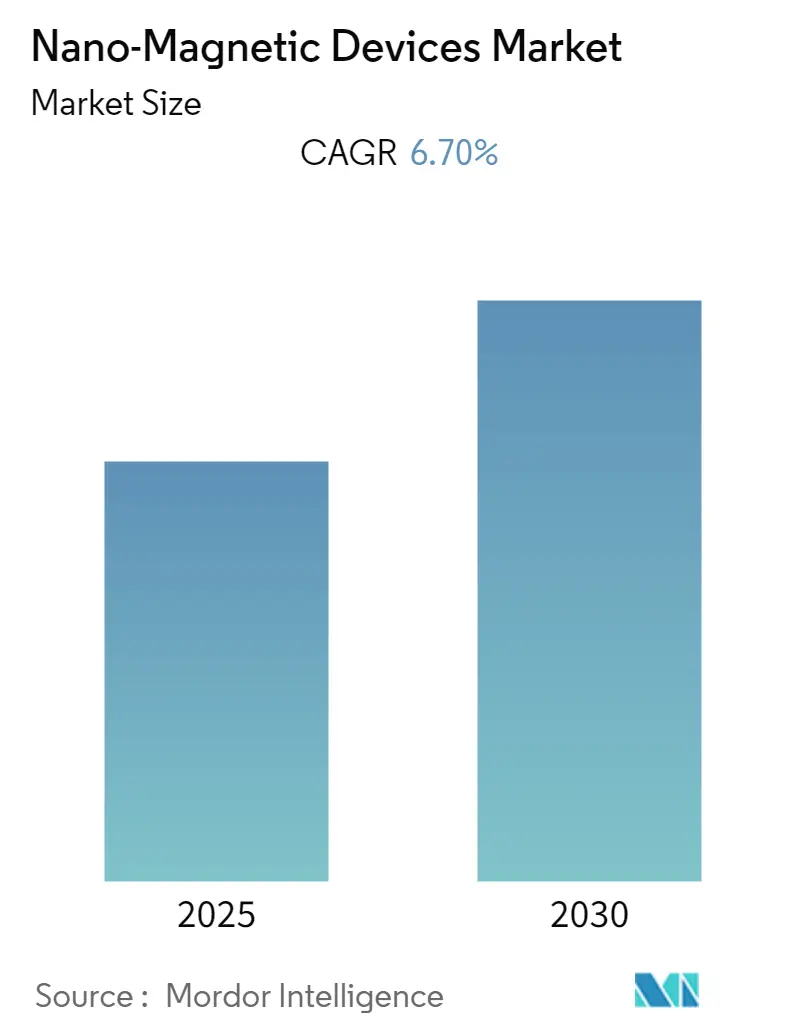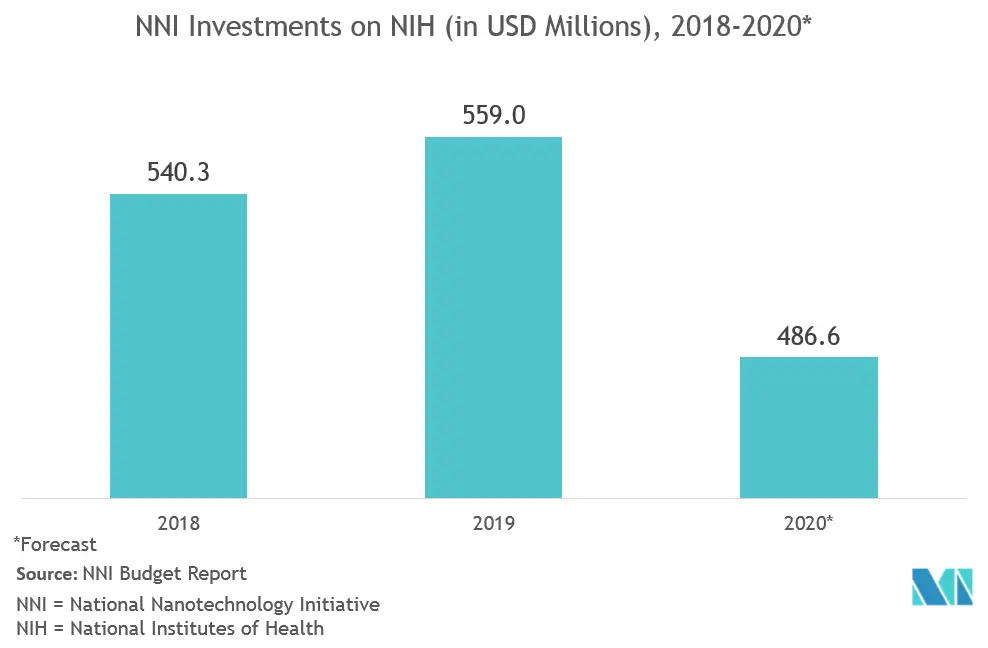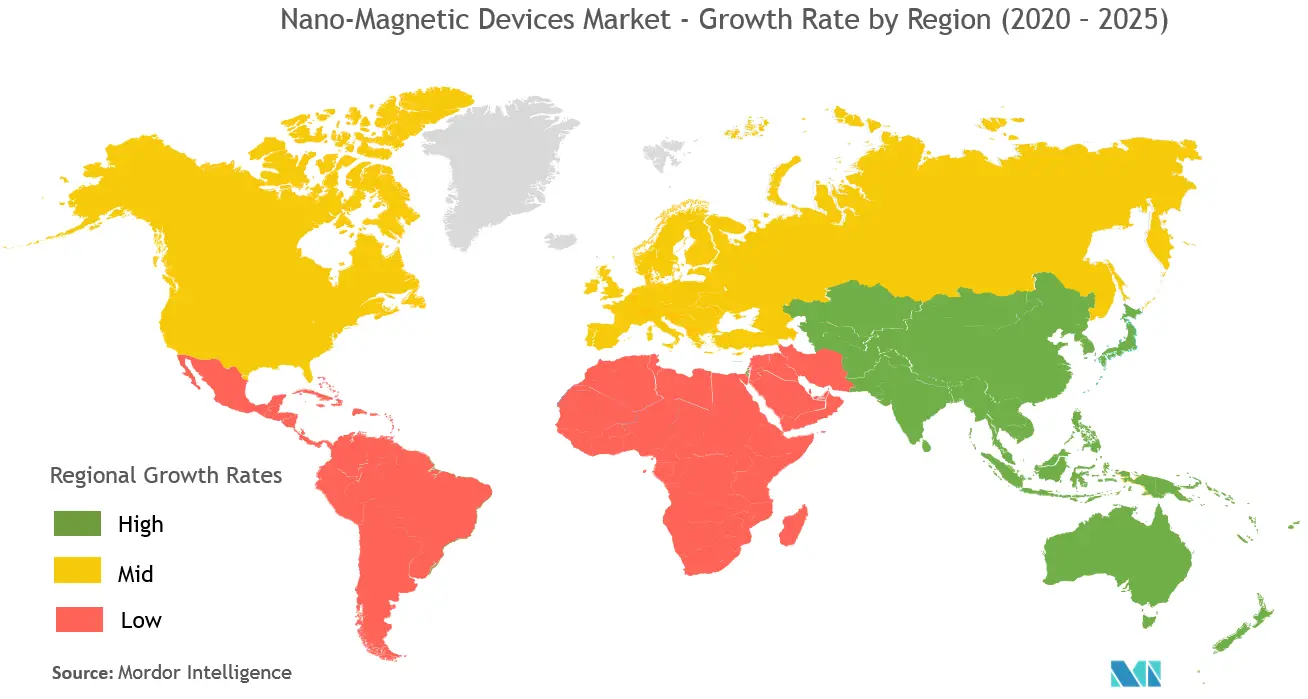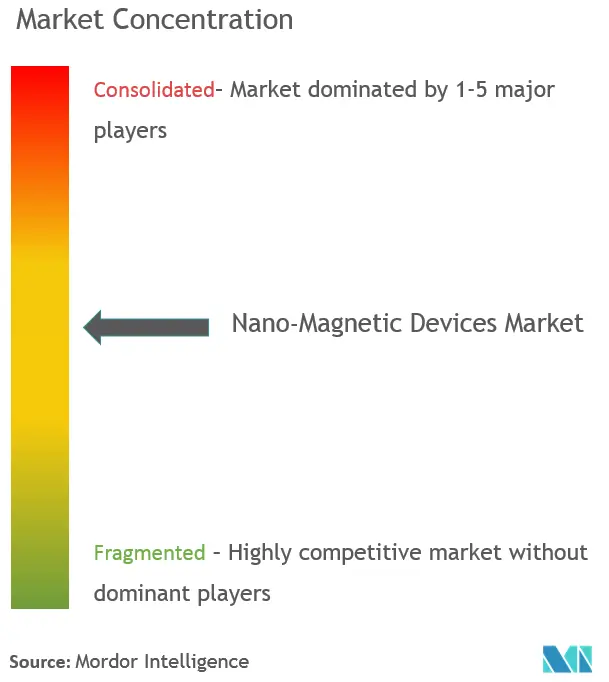Nano-Magnetic Devices Market Analysis
The Nano-Magnetic Devices Market is expected to register a CAGR of 6.7% during the forecast period.
- Nano-magnetic devices have gained traction in recent times; this is mostly due to the rising adoption of advanced and modernized electronic appliances. Increasing initiatives in some developed economies related to nanotechnology are contributing to the development growth of nano-magnetic devices.
- The increasing pace of research related to nano-magnetic device associated technologies are also creating opportunities for the market. For instance, in October 2019, researchers at the IIT Hyderabad (India) have developed low-power chips, which can be used in AI-powered devices. The researchers have developed magnetic quantum-dot cellular automata (MQCA)-based nano-magnetic logic design methodology of arithmetic circuits.
- In May 2020, a team of researchers of ICMAB, the UAB, and the ALBA Synchrotron, along with a bunch of scientists from the ICN2and the UB, have developed nanoneedles to improve robustness and capacity of magnetic memory devices.
- In April 2020, a research funded by Sandia National Laboratories and a National Science Foundation has developed magnetic nanowires to build more energy-efficient smart computers rather than using silicon chips.
- With the increasing incidences of COVID-19 across the globe, vendors present in the market are investing in research activities for the development of nanotechnology-enabled sensors to fight against the lethal virus.
- For instance, in April 2020, a group of engineers at Washington University in St. Louis received federal funding for a rapid Coronavirus test using a newly developed nanotechnology. The group has developed a highly sensitive and significantly accurate biosensor based on a fluorescent nanoprobe, which can be deployed across broad COVID-19 testing applications.
Nano-Magnetic Devices Market Trends
Healthcare is Expected to Grow at a Significant Rate Throughout the Forecast Period
- The major driver for the healthcare segment of the market is the increasing research & development activities across developed economies. For instance, in January 2020, KAUST scientists jointly produced drug-coated iron nanowires to kill malignant and tumor cells selectively. Iron nanowires coated with drugs can be a better option for malignant cell therapy as they can be moved to the tumor site with the help of an external magnetic field before starting a cancer-killing process.
- In May 2020, the researchers at the Immanuel Kant Baltic Federal University, with scientists at the Department of Physics of the Lomonosov Moscow State University, have developed a sensor that combines advanced technologies in the fields of magnetism solid-state physics. The newly developed sensor can be applied in the field of biomedicine.
- In May 2020, Nanoscope Therapeutics Inc. received NIH support to increase the pace of ultrafast laser-based retina gene delivery. The company has developed Multi-Characteristic Opsins (MCOs) to steer cells toward low levels of white light, which results in an improved vision at ambient room light.
- Many medical research organizations use a low power NIR laser beam whose intensity can be enhanced locally, to minimize significant damage while inserting therapeutic genes. With the help of nano-magnetic sensors, it can be achieved at a lesser cost. These ongoing research activities will drive the growth of the healthcare segment in the coming years.
North America Geographic Segment is Expected to Hold a Significant Share Over the Forecast Period
- The increasing investment by countries like the United States is driving the growth of the region. The United States President’s 2020 Budget requests over USD 1.4 billion for the National Nanotechnology Initiative, a continued investment in basic research, and technology transfer efforts that are heading to future innovations.
- In February 2020, NanoCanada, a Canadian nanotechnology community, completed its 5th mission to “Nanotech Japan.” More than twenty participants across Canada joined the mission that included site visits in Seoul and Tokyo, along with participation in the world’s one of the significantly major nanotechnology showcases. These initiatives will help to build business relationships and technology transferring networks across the globe.
- In June 2019, researchers at Oregon State University developed an improved technique for using magnetic nanoclusters to kill difficult-to-reach tumors. The University has developed a “systemic” delivery technique called “intravenous injection,” which has considered to be much easier and fruitful.
- Moreover, the factors which are also driving the growth of the region are the high concentration of significant manufacturers, the rising infrastructural development, and the increasing rate of urbanization.
Nano-Magnetic Devices Industry Overview
The nano-magnetic devices market is moderately competitive and comprises a significant number of regional and global players. These players account for a considerable share in the market and focusing on expanding their customer base across the globe. These vendors are focusing on the research and development investment in introducing new products & solutions, strategic alliances, and other organic & inorganic growth strategies to earn a competitive edge during the forecast period.
- In February 2020, Allegro MicroSystems, a significant player in power and sensing solutions, announced the launch of the back-biased GMR transmission speed and direction sensor, which is one type of nano-magnetic sensor product. The newly developed sensor product can reduce the system complexity and cost, resulting in improved fuel economy.
- In February 2020, Everspin Technologies Inc. announced the release of STT-Magnetoresistive RAM, specially designed for Industrial applications. The newly launched product helps to increase the reliability and performance of industrial systems where data persistence is critical.
Nano-Magnetic Devices Market Leaders
-
IBM Corporation
-
Fujitsu Limited
-
Nanomagnetics Instruments
-
Hitachi Metals America Limited
-
Honeywell International Inc.
- *Disclaimer: Major Players sorted in no particular order
Nano-Magnetic Devices Industry Segmentation
The nano-magnetic devices offer a reduced size of electronics, increase its efficiency, and also help to increase product longevity. The nano-magnetic devices market tracks down the adoption of different types of devices like data storage devices, imaging devices, etc. The market study also focuses on the penetration of these devices in various end-use verticals like IT & telecom, energy & utilities, healthcare, etc.
| Type | Sensors |
| Data Storage Devices | |
| Imaging Devices | |
| Others | |
| End-use Vertical | IT & Telecom |
| Energy & Utilities | |
| Healthcare | |
| Other Verticals | |
| Geography | North America |
| Europe | |
| Asia Pacific | |
| Latin America | |
| Middle East and Africa |
Nano-Magnetic Devices Market Research FAQs
What is the current Nano-Magnetic Devices Market size?
The Nano-Magnetic Devices Market is projected to register a CAGR of 6.7% during the forecast period (2025-2030)
Who are the key players in Nano-Magnetic Devices Market?
IBM Corporation, Fujitsu Limited, Nanomagnetics Instruments, Hitachi Metals America Limited and Honeywell International Inc. are the major companies operating in the Nano-Magnetic Devices Market.
Which is the fastest growing region in Nano-Magnetic Devices Market?
Asia Pacific is estimated to grow at the highest CAGR over the forecast period (2025-2030).
Which region has the biggest share in Nano-Magnetic Devices Market?
In 2025, the North America accounts for the largest market share in Nano-Magnetic Devices Market.
What years does this Nano-Magnetic Devices Market cover?
The report covers the Nano-Magnetic Devices Market historical market size for years: 2019, 2020, 2021, 2022, 2023 and 2024. The report also forecasts the Nano-Magnetic Devices Market size for years: 2025, 2026, 2027, 2028, 2029 and 2030.
Our Best Selling Reports
Nano-Magnetic Devices Industry Report
Statistics for the 2025 Nano-Magnetic Devices market share, size and revenue growth rate, created by Mordor Intelligence™ Industry Reports. Nano-Magnetic Devices analysis includes a market forecast outlook for 2025 to 2030 and historical overview. Get a sample of this industry analysis as a free report PDF download.

